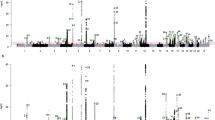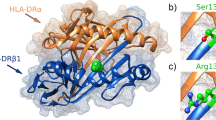Abstract
We conducted a genome-wide association study for testicular germ cell tumor, genotyping 298,782 SNPs in 979 affected individuals and 4,947 controls from the UK and replicating associations in a further 664 cases and 3,456 controls. We identified three new susceptibility loci, two of which include genes that are involved in telomere regulation. We identified two independent signals within the TERT-CLPTM1L locus on chromosome 5, which has previously been associated with multiple other cancers (rs4635969, OR = 1.54, P = 1.14 × 10−23; rs2736100, OR = 1.33, P = 7.55 × 10−15). We also identified a locus on chromosome 12 (rs2900333, OR = 1.27, P = 6.16 × 10−10) that contains ATF7IP, a regulator of TERT expression. Finally, we identified a locus on chromosome 9 (rs755383, OR = 1.37, P = 1.12 × 10−23), containing the sex determination gene DMRT1, which has been linked to teratoma susceptibility in mice.
This is a preview of subscription content, access via your institution
Access options
Subscribe to this journal
Receive 12 print issues and online access
$209.00 per year
only $17.42 per issue
Buy this article
- Purchase on Springer Link
- Instant access to full article PDF
Prices may be subject to local taxes which are calculated during checkout

Similar content being viewed by others
References
Ferlay, J., Bray, F., Pisani, P. & Parkin, D.M. GLOBOCAN 2002: Cancer Incidence, Mortality and Prevalence Worldwide (IARC CancerBase No. 5. version 2.0, IARCPress, Lyon, France, 2004).
Horwich, A., Shipley, J. & Huddart, R. Testicular germ-cell cancer. Lancet 367, 754–765 (2006).
Hemminki, K. & Li, X. Familial risk in testicular cancer as a clue to a heritable and environmental aetiology. Br. J. Cancer 90, 1765–1770 (2004).
Rashid, H.H., Cos, L.R., Weinberg, E. & Messing, E.M. Testicular microlithiasis: a review and its association with testicular cancer. Urol. Oncol. 22, 285–289 (2004).
Nathanson, K.L. et al. The Y deletion gr/gr and susceptibility to testicular germ cell tumor. Am. J. Hum. Genet. 77, 1034–1043 (2005).
Horvath, A. et al. Functional phosphodiesterase 11A mutations may modify the risk of familial and bilateral testicular germ cell tumors. Cancer Res. 69, 5301–5306 (2009).
Rapley, E.A. et al. A genome-wide association study of testicular germ cell tumor. Nat. Genet. 41, 807–810 (2009).
Kanetsky, P.A. et al. Common variation in KITLG and at 5q31.3 predisposes to testicular germ cell cancer. Nat. Genet. 41, 811–815 (2009).
Wang, Y. et al. Common 5p15.33 and 6p21.33 variants influence lung cancer risk. Nat. Genet. 40, 1407–1409 (2008).
McKay, J.D. et al. Lung cancer susceptibility locus at 5p15.33. Nat. Genet. 40, 1404–1406 (2008).
Landi, M.T. et al. A genome-wide association study of lung cancer identifies a region of chromosome 5p15 associated with risk for adenocarcinoma. Am. J. Hum. Genet. 85, 679–691 (2009).
Rafnar, T. et al. Sequence variants at the TERT-CLPTM1L locus associate with many cancer types. Nat. Genet. 41, 221–227 (2009).
Stacey, S.N. et al. New common variants affecting susceptibility to basal cell carcinoma. Nat. Genet. 41, 909–914 (2009).
Shete, S. et al. Genome-wide association study identifies five susceptibility loci for glioma. Nat. Genet. 41, 899–904 (2009).
Petersen, G.M. et al. A genome-wide association study identifies pancreatic cancer susceptibility loci on chromosomes 13q22.1, 1q32.1 and 5p15.33. Nat. Genet. 42, 224–228 (2010).
Yamamoto, K., Okamoto, A., Isonishi, S., Ochiai, K. & Ohtake, Y. A novel gene, CRR9, which was up-regulated in CDDP-resistant ovarian tumor cell line, was associated with apoptosis. Biochem. Biophys. Res. Commun. 280, 1148–1154 (2001).
Masters, J.R. & Koberle, B. Curing metastatic cancer: lessons from testicular germ-cell tumours. Nat. Rev. Cancer 3, 517–525 (2003).
Feldser, D.M., Hackett, J.A. & Greider, C.W. Telomere dysfunction and the initiation of genome instability. Nat. Rev. Cancer 3, 623–627 (2003).
Hackett, J.A., Feldser, D.M. & Greider, C.W. Telomere dysfunction increases mutation rate and genomic instability. Cell 106, 275–286 (2001).
Fernandez-Garcia, I., Ortiz-de-Solorzano, C. & Montuenga, L.M. Telomeres and telomerase in lung cancer. J. Thorac. Oncol. 3, 1085–1088 (2008).
Kang, J.U., Koo, S.H., Kwon, K.C., Park, J.W. & Kim, J.M. Gain at chromosomal region 5p15.33, containing TERT, is the most frequent genetic event in early stages of non-small cell lung cancer. Cancer Genet. Cytogenet. 182, 1–11 (2008).
Zhang, A. et al. Genetic alterations in cervical carcinomas: frequent low-level amplifications of oncogenes are associated with human papillomavirus infection. Int. J. Cancer 101, 427–433 (2002).
Schrader, M. et al. Quantification of human telomerase reverse transcriptase mRNA in testicular germ cell tumors by quantitative fluorescence real-time RT-PCR. Oncol. Rep. 9, 1097–1105 (2002).
Schrader, M. et al. The differentiation status of primary gonadal germ cell tumors correlates inversely with telomerase activity and the expression level of the gene encoding the catalytic subunit of telomerase. BMC Cancer 2, 32 (2002).
Liu, L. et al. MCAF1/AM is involved in Sp1-mediated maintenance of cancer-associated telomerase activity. J. Biol. Chem. 284, 5165–5174 (2009).
Krentz, A.D. et al. The DM domain protein DMRT1 is a dose-sensitive regulator of fetal germ cell proliferation and pluripotency. Proc. Natl. Acad. Sci. USA 106, 22323–22328 (2009).
Smith, C.A., McClive, P.J., Western, P.S., Reed, K.J. & Sinclair, A.H. Conservation of a sex-determining gene. Nature 402, 601–602 (1999).
Barbaro, M. et al. Characterization of deletions at 9p affecting the candidate regions for sex reversal and deletion 9p syndrome by MLPA. Eur. J. Hum. Genet. 17, 1439–1447 (2009).
Livadas, S. et al. Gonadoblastoma in a patient with del(9)(p22) and sex reversal: report of a case and review of the literature. Cancer Genet. Cytogenet. 143, 174–177 (2003).
Myers, S., Bottolo, L., Freeman, C., McVean, G. & Donnelly, P. A fine-scale map of recombination rates and hotspots across the human genome. Science 310, 321–324 (2005).
Acknowledgements
We thank subjects with TGCT and the clinicians involved in their care for participation in this study. We also thank D. Dudakia, J. Pugh, H. McDonald and J. Marke for recruitment of subjects and database entry for the TGCT collections. We acknowledge National Health Service funding to the National Institute for Health Research Biomedical Research Centre. We acknowledge use of DNA from the British 1958 Birth Cohort DNA collection, funded by the Medical Research Council grant G0000934 and the Wellcome Trust grant 068545/Z/02. C.T. is a Medical Research Council Clinical Research Fellow. D.F.E. is a Principal Research Fellow of Cancer Research UK. The study was supported by the Institute of Cancer Research, Cancer Research UK and the Wellcome Trust.
Author information
Authors and Affiliations
Consortia
Contributions
M.R.S., E.A.R., D.T.B. and D.F.E. designed the study and obtained financial support. N.R., E.A.R., R.A.H., U.K.T.C.C. and M.R.S. coordinated the studies and provided samples for stage 1 and stage 2. P.D. directed genotyping of stage 1. N.R. and C.T. directed genotyping of stage 2. S.S., E.A.R., R.L. and D.H. coordinated sample management and transfer. A.R., D.H., M.R., R.L. and S.S. conducted genotyping of stage 2. D.P. coordinated data transfer and storage. C.T. designed and conducted statistical analyses with D.F.E. C.T. and N.R. drafted the manuscript. All authors contributed to the final paper.
Corresponding author
Ethics declarations
Competing interests
The authors declare no competing financial interests.
Additional information
A full list of members is provided in the Supplementary Note.
Supplementary information
Supplementary Text and Figures
Supplementary Note, Supplementary Tables 1–9 and Supplementary Figure 1 (PDF 115 kb)
Rights and permissions
About this article
Cite this article
Turnbull, C., Rapley, E., Seal, S. et al. Variants near DMRT1, TERT and ATF7IP are associated with testicular germ cell cancer. Nat Genet 42, 604–607 (2010). https://doi.org/10.1038/ng.607
Received:
Accepted:
Published:
Issue Date:
DOI: https://doi.org/10.1038/ng.607
This article is cited by
-
FGF-independent MEK1/2 signalling in the developing foetal testis is essential for male germline differentiation in mice
BMC Biology (2023)
-
Integrated genomic analysis reveals aberrations in WNT signaling in germ cell tumors of childhood and adolescence
Nature Communications (2023)
-
Implementation of individualised polygenic risk score analysis: a test case of a family of four
BMC Medical Genomics (2022)
-
Predicted leukocyte telomere length and risk of germ cell tumours
British Journal of Cancer (2022)
-
An international study evaluating the epidemiology of intracranial germ cell tumors in the native versus immigrant Japanese populations: the need for an international registry
Journal of Neuro-Oncology (2022)



